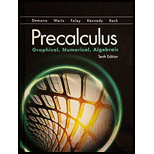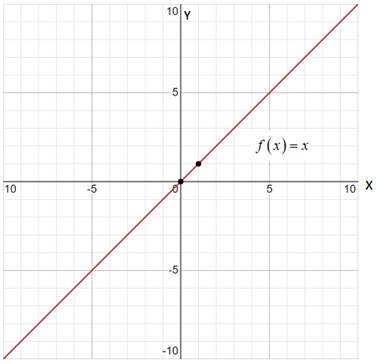
Concept explainers
The complete analysis of given function.
Domain:
Range:
Continuity:
Increasing-decreasing behaviour: The graph is always increasing.
Symmetry: The function is odd, so, the graph is symmetric about the origin.
Boundedness: Upper and lower bound
Local extrema: No Local Extrema
Horizontal asymptotes: No Asymptotes
Vertical asymptotes: No Asymptotes
End behaviour: Th graph falls to the left and rises to the right
Given:
Graph:

Domain:
The domain of the expression is all real numbers except where the expression is undefined. In this case, there is no real number that makes the expression undefined.
Interval Notation:
Set-Builder Notation:
Range:
The range is the set of all valid
Interval Notation:
Set-Builder Notation:
Continuity:
Since the domain is all real numbers,
Increasing-decreasing behaviour:
The function
Symmetry:
To determine if the function is odd, even, or neither in order to find the symmetry.
If the function is odd, the function is symmetric about the origin. And ff the function is even, the function is symmetric about the y-axis.
Find
A function is even if
Check if
Since
The function is not even.
A function is odd if
Multiply
Since
The function is odd.
Since the function is odd, the graph is symmetric about the origin.
Boundedness:
Find every combination of
If a polynomial function has integer coefficients, then every rational zero will have the form
Find every combination of
Apply synthetic division on
Since
Upper and lower bound:
Local extrema:
Differentiate
Since
To find the local maximum and minimum values of the function, set the derivative equal to
Since there is no value of
Horizontal asymptotes:
Since
Vertical asymptotes:
Since
End behaviour:
The largest exponent is the degree of the polynomial is
Since the degree is odd, the ends of the function will point in the opposite directions. Falls to the left and rises to the right
Since the leading coefficient is positive, the graph rises to the right.
From analysing the graph, the function falls to the left and rises to the right
Chapter 2 Solutions
EBK PRECALCULUS:GRAPHICAL,...-NASTA ED.
- 74. Geometry of implicit differentiation Suppose x and y are related 0. Interpret the solution of this equa- by the equation F(x, y) = tion as the set of points (x, y) that lie on the intersection of the F(x, y) with the xy-plane (z = 0). surface Z = a. Make a sketch of a surface and its intersection with the xy-plane. Give a geometric interpretation of the result that dy dx = Fx F χ y b. Explain geometrically what happens at points where F = 0. yarrow_forwardExample 3.2. Solve the following boundary value problem by ADM (Adomian decomposition) method with the boundary conditions მი მი z- = 2x²+3 дг Əz w(x, 0) = x² - 3x, θω (x, 0) = i(2x+3). ayarrow_forward6. A particle moves according to a law of motion s(t) = t3-12t2 + 36t, where t is measured in seconds and s is in feet. (a) What is the velocity at time t? (b) What is the velocity after 3 s? (c) When is the particle at rest? (d) When is the particle moving in the positive direction? (e) What is the acceleration at time t? (f) What is the acceleration after 3 s?arrow_forward
- Construct a table and find the indicated limit. √√x+2 If h(x) = then find lim h(x). X-8 X-8 Complete the table below. X 7.9 h(x) 7.99 7.999 8.001 8.01 8.1 (Type integers or decimals rounded to four decimal places as needed.)arrow_forwardUse the graph to find the following limits. (a) lim f(x) (b) lim f(x) X-1 x→1 (a) Find lim f(x) or state that it does not exist. Select the correct choice X-1 below and, if necessary, fill in the answer box within your choice. OA. lim f(x) = X-1 (Round to the nearest integer as needed.) OB. The limit does not exist. Qarrow_forwardOfficials in a certain region tend to raise the sales tax in years in which the state faces a budget deficit and then cut the tax when the state has a surplus. The graph shows the region's sales tax in recent years. Let T(x) represent the sales tax per dollar spent in year x. Find the desired limits and values, if they exist. Note that '01 represents 2001. Complete parts (a) through (e). Tax (in cents) T(X)4 8.5 8- OA. lim T(x)= cent(s) X-2007 (Type an integer or a decimal.) OB. The limit does not exist and is neither ∞ nor - ∞. Garrow_forward
- Decide from the graph whether each limit exists. If a limit exists, estimate its value. (a) lim F(x) X➡-7 (b) lim F(x) X-2 (a) What is the value of the limit? Select the correct choice below and, if necessary, fill in the answer box within your choice. OA. lim F(x) = X-7 (Round to the nearest integer as needed.) OB. The limit does not exist. 17 Garrow_forwardFin lir X- a= (Us -10 OT Af(x) -10- 10arrow_forwardFind all values x = a where the function is discontinuous. For each value of x, give the limit of the function as x approaches a. Be sure to note when the limit doesn't exist. f(x)=4x²+7x+1 Select the correct choice below and, if necessary, fill in the answer box(es) to complete your choice. (Use a comma to separate answers as needed.) OA. f is discontinuous at the single value x = B. f is discontinuous at the single value x = OC. f is discontinuous at the two values x = OD. fis discontinuous at the two values x = OE. f is discontinuous at the two values x = The limit is The limit does not exist and is not co or - oo. The limit for the smaller value is The limit for the larger value is The limit for both values do not exist and are not co or - co. The limit for the smaller value does not exist and is not oo or - co. The limit for the larger value isarrow_forward
- Find all values x = a where the function is discontinuous. For each value of x, give the limit of the function as x approaches a. Be sure to note when the limit doesn't exist. 8+x f(x) = x(x-1) (Use a comma to separate answers as needed.) OA. The function f is discontinuous at the single value x = OB. The function f is discontinuous at the single value x = OC. The function f is discontinuous at the two values x = OD. The function f is discontinuous at the two values x = not oo or -0. OE. The function f is discontinuous at the two values x = The limit is The limit does not exist and is not oo or - co. The limits for both values do not exist and are not co or - co. The limit for the smaller value is The limit for the larger value does not exist and is The limit for the smaller value does not exist and is not co or - co. The limit for the largerarrow_forwardi need help please . and please dont use chat gpt i am trying to learn and see the mistake i did when solving minearrow_forwardi need help please . and please dont use chat gpt i am trying to learn and see the mistake i did when solving minearrow_forward
 Calculus: Early TranscendentalsCalculusISBN:9781285741550Author:James StewartPublisher:Cengage Learning
Calculus: Early TranscendentalsCalculusISBN:9781285741550Author:James StewartPublisher:Cengage Learning Thomas' Calculus (14th Edition)CalculusISBN:9780134438986Author:Joel R. Hass, Christopher E. Heil, Maurice D. WeirPublisher:PEARSON
Thomas' Calculus (14th Edition)CalculusISBN:9780134438986Author:Joel R. Hass, Christopher E. Heil, Maurice D. WeirPublisher:PEARSON Calculus: Early Transcendentals (3rd Edition)CalculusISBN:9780134763644Author:William L. Briggs, Lyle Cochran, Bernard Gillett, Eric SchulzPublisher:PEARSON
Calculus: Early Transcendentals (3rd Edition)CalculusISBN:9780134763644Author:William L. Briggs, Lyle Cochran, Bernard Gillett, Eric SchulzPublisher:PEARSON Calculus: Early TranscendentalsCalculusISBN:9781319050740Author:Jon Rogawski, Colin Adams, Robert FranzosaPublisher:W. H. Freeman
Calculus: Early TranscendentalsCalculusISBN:9781319050740Author:Jon Rogawski, Colin Adams, Robert FranzosaPublisher:W. H. Freeman
 Calculus: Early Transcendental FunctionsCalculusISBN:9781337552516Author:Ron Larson, Bruce H. EdwardsPublisher:Cengage Learning
Calculus: Early Transcendental FunctionsCalculusISBN:9781337552516Author:Ron Larson, Bruce H. EdwardsPublisher:Cengage Learning





